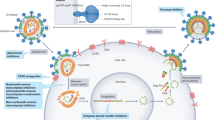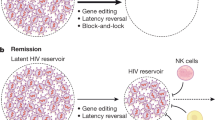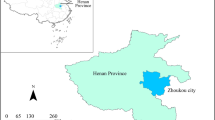Abstract
In the early years of the AIDS epidemic, a diagnosis of HIV-1 infection was equivalent to a death sentence. The development of combination antiretroviral therapy (cART) in the 1990s to combat HIV-1 infection was one of the most impressive achievements of medical science. Today, patients who are treated early with cART can expect a near-normal lifespan. In this Opinion article, we propose a fundamental theory to explain the mechanistic basis of cART and why it works so well, including a model to assess and predict the efficacy of antiretroviral drugs alone or in combination.
This is a preview of subscription content, access via your institution
Access options
Subscribe to this journal
Receive 12 print issues and online access
$209.00 per year
only $17.42 per issue
Buy this article
- Purchase on Springer Link
- Instant access to full article PDF
Prices may be subject to local taxes which are calculated during checkout



Similar content being viewed by others
References
Slutsker, M. D. L. 1993 revised classification system for HIV infection and expanded surveillance case definition for AIDS among adolescents and adults. MMWR Recomm. Rep. 41, 1–19 (1992).
Feng, Y., Broder, C. C., Kennedy, P. E. & Berger, E. A. HIV-1 entry cofactor: functional cDNA cloning of a seven-transmembrane, G protein-coupled receptor. Science 272, 872–877 (1996).
Choe, H. et al. The β-chemokine receptors CCR3 and CCR5 facilitate infection by primary HIV-1 isolates. Cell 85, 1135–1148 (1996).
Arts, E. J. & Hazuda, D. J. HIV-1 antiretroviral drug therapy. Cold Spring Harb. Perspect. Med. 2, a007161 (2012).
Finzi, D. et al. Latent infection of CD4+ T cells provides a mechanism for lifelong persistence of HIV-1, even in patients on effective combination therapy. Nature Med. 5, 512–517 (1999).
Salgado, M. et al. Prolonged control of replication-competent dual- tropic human immunodeficiency virus-1 following cessation of highly active antiretroviral therapy. Retrovirology 8, 97 (2011).
Sáez-Cirión, A. et al. Post-treatment HIV-1 controllers with a long-term virological remission after the interruption of early initiated antiretroviral therapy ANRS VISCONTI Study. PLoS Pathog. 9, e1003211 (2013).
Davey, R. T. et al. HIV-1 and T cell dynamics after interruption of highly active antiretroviral therapy (HAART) in patients with a history of sustained viral suppression. Proc. Natl Acad. Sci. USA 96, 15109–15114 (1999).
Richman, D. D. et al. The challenge of finding a cure for HIV infection. Science 323, 1304–1307 (2009).
Siliciano, J. D. & Siliciano, R. F. Recent trends in HIV-1 drug resistance. Curr. Opin. Virol. 3, 487–494 (2013).
Thompson, M. A. et al. Antiretroviral treatment of adult HIV infection: 2012 recommendations of the International Antiviral Society — USA panel. JAMA 308, 387–402 (2012).
Jilek, B. L. et al. A quantitative basis for antiretroviral therapy for HIV-1 infection. Nature Med. 18, 446–451 (2012).
Bierman, F. W., van Agtmael, M. A., Nijhuis, M., Danner, S. A. & Boucher, C. A. HIV monotherapy with ritonavir-boosted protease inhibitors: a systematic review. AIDS 23, 279–291 (2009).
Mathis, S. et al. Effectiveness of protease inhibitor monotherapy versus combination antiretroviral maintenance therapy: a meta-analysis. PLoS ONE 6, e22003 (2011).
Shen, L. et al. Dose–response curve slope sets class-specific limits on inhibitory potential of anti-HIV drugs. Nature Med. 14, 762–766 (2008).
World Health Organization. WHO HIV drug resistance report 2012 (WHO Press, 2012).
Broder, S. Twenty-five years of translational medicine in antiretroviral therapy: promises to keep. Sci. Transl. Med. 2, 39ps33 (2010).
Broder, S. The development of antiretroviral therapy and its impact on the HIV-1/AIDS pandemic. Antiviral Res. 85, 1–18 (2010).
Mitsuya, H. et al. 3′-Azido-3′-deoxythymidine (BW A509U): an antiviral agent that inhibits the infectivity and cytopathic effect of human T-lymphotropic virus type III/lymphadenopathy-associated virus in vitro. Proc. Natl Acad. Sci. USA 82, 7096–7100 (1985).
Fischl, M. A. et al. The efficacy of azidothymidine (AZT) in the treatment of patients with AIDS and AIDS-related complex. A double-blind, placebo-controlled trial. N. Engl. J. Med. 317, 185–191 (1987).
Larder, B. A., Darby, G. & Richman, D. D. HIV with reduced sensitivity to zidovudine (AZT) isolated during prolonged therapy. Science 243, 1731–1734 (1989).
Hammer, S. M. et al. A trial comparing nucleoside monotherapy with combination therapy in HIV-infected adults with CD4 cell counts from 200 to 500 per cubic millimeter. N. Engl. J. Med. 335, 1081–1090 (1996).
Wei, X. et al. Viral dynamics in human immunodeficiency virus type 1 infection. Nature 373, 117–122 (1995).
Ho, D. D. et al. Rapid turnover of plasma virions and CD4 lymphocytes in HIV-1 infection. Nature 373, 123–126 (1995).
Hammer, S. M. et al. A controlled trial of two nucleoside analogues plus indinavir in persons with human immunodeficiency virus infection and CD4 cell counts of 200 per cubic millimeter or less. N. Engl. J. Med. 337, 725–733 (1997).
Gulick, R. M. et al. Treatment with indinavir, zidovudine, and lamivudine in adults with human immunodeficiency virus infection and prior antiretroviral therapy. N. Engl. J. Med. 337, 734–739 (1997).
Perelson, A. S. et al. Decay characteristics of HIV-1-infected compartments during combination therapy. Nature 387, 188–191 (1997).
Palella, F. J. et al. Declining morbidity and mortality among patients with advanced human immunodeficiency virus infection. N. Engl. J. Med. 338, 853–860 (1998).
Palmer, S. et al. Low-level viremia persists for at least 7 years in patients on suppressive antiretroviral therapy. Proc. Natl Acad. Sci. USA 105, 3879–3884 (2008).
Finzi, D. et al. Identification of a reservoir for HIV-1 in patients on highly active antiretroviral therapy. Science 278, 1295–1300 (1997).
Wong, J. K. et al. Recovery of replication-competent HIV despite prolonged suppression of plasma viremia. Science 278, 1291–1295 (1997).
Chun, T. et al. Presence of an inducible HIV-1 latent reservoir during highly active antiretroviral therapy. Proc. Natl Acad. Sci. USA 94, 13193–13197 (1997).
Mansky, L. M. & Temin, H. M. Lower in vivo mutation rate of human immunodeficiency virus type 1 than that predicted from the fidelity of purified reverse transcriptase. J. Virol. 69, 5087–5094 (1995).
Kieffer, T. L. et al. Genotypic analysis of HIV-1 drug resistance at the limit of detection: virus production without evolution in treated adults with undetectable HIV loads. J. Infect. Dis. 189, 1452–1465 (2004).
Bailey, J. R. et al. Residual human immunodeficiency virus type 1 viremia in some patients on antiretroviral therapy is dominated by a small number of invariant clones rarely found in circulating CD4+ T cells. J. Virol. 80, 6441–6457 (2006).
Sedaghat, A. R., Siliciano, J. D., Brennan, T. P., Wilke, C. O. & Siliciano, R. F. Limits on replenishment of the resting CD4+ T cell reservoir for HIV in patients on HAART. PLoS Pathog. 3, e122 (2007).
Evering, T. et al. Absence of HIV-1 evolution in the gut-associated lymphoid tissue from patients on combination antiviral therapy initiated during primary infection. PLoS Pathog. 8, e1002506 (2012).
Josefsson, L. et al. The HIV-1 reservoir in eight patients on long-term suppressive antiretroviral therapy is stable with few genetic changes over time. Proc. Natl Acad. Sci. USA 110, E4987–E4996 (2013).
Frenkel, L. M. et al. Multiple viral genetic analyses detect low-level human immunodeficiency virus type 1 replication during effective highly active antiretroviral therapy. J. Virol. 77, 5721–5730 (2003).
Tobin, N. et al. Evidence that low-level viremias during effective highly active antiretroviral therapy result from two processes: expression of archival virus and replication of virus. J. Virol. 79, 9625–9634 (2005).
Bontell, I., Häggblom, A., Bratt, G., Albert, J. & Sönnerborg, A. Trends in antiretroviral therapy and prevalence of HIV drug resistance mutations in Sweden 1997–2011. PLoS ONE 8, e59337 (2013).
De Luca, A. et al. Declining prevalence of HIV-1 drug resistance in antiretroviral treatment-exposed individuals in Western Europe. J. Infect. Dis. 207, 1216–1220 (2013).
Dinoso, J. B. et al. Treatment intensification does not reduce residual HIV-1 viremia in patients on highly active antiretroviral therapy. Proc. Natl Acad. Sci. USA 106, 9403–9408 (2009).
Yukl, S. A. et al. Effect of raltegravir-containing intensification on HIV burden and T-cell activation in multiple gut sites of HIV-positive adults on suppressive antiretroviral therapy. AIDS 24, 2451–2460 (2010).
Gandhi, R. T. et al. The effect of raltegravir intensification on low-level residual viremia in HIV-infected patients on antiretroviral therapy: a randomized controlled trial. PLoS Med. 7, e1000321 (2010).
Dahl, V. et al. Raltegravir treatment intensification does not alter cerebrospinal fluid HIV-1 infection or immunoactivation in subjects on suppressive therapy. J. Infect. Dis. 204, 1936–1945 (2011).
Buzón, M. J. et al. HIV-1 replication and immune dynamics are affected by raltegravir intensification of HAART-suppressed subjects. Nature Med. 16, 460–465 (2010).
Hatano, et al. Increase in 2-long terminal repeat circles and decrease in D-dimer after raltegravir intensification in patients with treated HIV infection: a randomized, placebo-controlled trial. J. Infect. Dis. 208, 1436–1442 (2013).
Henrich, T. J. et al. Antiretroviral-free HIV-1 remission and viral rebound after allogeneic stem cell transplantation: report of 2 cases. Ann. Intern. Med. 161, 319–327 (2014).
Persaud, D. et al. Absence of detectable HIV-1 viremia after treatment cessation in an infant. N. Engl. J. Med. 369, 1828–1835 (2013).
Hill, A. L. et al. Predicting the outcomes of treatment to eradicate the latent reservoir for HIV-1. Proc. Natl Acad. Sci. USA 111, 31475–31480 (2014).
Flexner, C. in Goodman and Gilman's The Pharmacological Basis of Therapeutics. 12th edn. (ed. Brunton, L. L.) 1623–1664 (McGraw-Hill Professional, 2011).
Chou, T.-C. Derivation and properties of Michaelis–Menten type and Hill type equations for reference ligands. J. Theor. Biol. 59, 253–276 (1976).
Hill, A. V. The possible effects of the aggregation of the molecules of haemoglobin on its dissociation curves. J. Physiol. 40, i–vii (1910).
Ellner, P. D. & Neu, H. C. The inhibitory quotient. A method for interpreting minimum inhibitory concentration data. JAMA 246, 1575–1578 (1981).
Valantin, M. A. et al. Long-term efficacy of darunavir/ritonavir monotherapy in patients with HIV-1 viral suppression: week 96 results from the MONOI ANRS 136 study. J. Antimicrob. Chemother. 67, 691–695 (2012).
Meynard, J.-L. et al. Lopinavir/ritonavir monotherapy versus current treatment continuation for maintenance therapy of HIV-1 infection: the KALESOLO trial. J. Antimicrob. Chemother. 65, 2436–2444 (2010).
Shen, L. et al. A critical subset model provides a conceptual basis for the high antiviral activity of major HIV drugs. Sci. Transl. Med. 3, 91ra63 (2011).
Lee, S.-K., Potempa, M. & Swanstrom, R. The choreography of HIV-1 proteolytic and virion assembly. J. Biol. Chem. 287, 40867–40874 (2012).
Rabi, S. A. et al. Multi-step inhibition explains HIV-1 protease inhibitor pharmacodynamics and resistance. J. Clin. Invest. 123, 3848–3860 (2013).
Kessl, J. J. et al. Multimode, cooperative mechanism of action of allosteric HIV-1 integrase inhibitors. J. Biol. Chem. 287, 16801–16811 (2012).
Jurado, K. A. et al. Allosteric integrase inhibitor potency is determined through the inhibition of HIV-1 particle maturation. Proc. Natl Acad. Sci. USA 110, 8690–8695 (2013).
Perelson, A. S., Neumann, A. U., Markowitz, M., Leonard, J. M. & Ho, D. D. HIV-1 dynamics in vivo: virion clearance rate, infected cell life-span, and viral generation time. Science 271, 1582–1586 (1996).
Wodarz, D. & Nowak, M. A. Mathematical models of HIV pathogenesis and treatment. Bioessays 24, 1178–1187 (2002).
Shen, L., Rabi, S. A. & Siliciano, R. F. A novel method for determining the inhibitory potential of anti-HIV drugs. Trends Pharmacol. Sci. 30, 610–616 (2009).
Sedaghat, A. R., Dinoso, J. B., Shen, L., Wilke, C. O. & Siliciano, R. F. Decay dynamics of HIV-1 depend on the inhibited stages of the viral life cycle. Proc. Natl Acad. Sci. USA 105, 4832–4837 (2008).
Stellbrink, H.-J. Raltegravir in the management of HIV-infected patients. Drug Des. Devel. Ther. 2, 281–288 (2008).
van Lunzen, J. et al. Once daily dolutegravir (S/GSK1349572) in combination therapy in antiretroviral-naive adults with HIV: planned interim 48 week results from SPRING-1, a dose-ranging, randomised, phase 2b trial. Lancet Infect. Dis. 12, 111–118 (2012).
Aldous, J. L. & Haubrich, R. Defining treatment failure in resource-rich settings. Curr. Opin. HIV AIDS 4, 459–466 (2009).
Clavel, F. & Hance, A. J. HIV drug resistance. N. Engl. J. Med. 350, 1023–1035 (2004).
Johnson, V. A. et al. Update of the drug resistance mutations in HIV-1: March 2013. Top. Antivir. Med. 21, 6–14 (2013).
Boyer, P. L., Sarafianos, S. G., Arnold, E. & Hughes, S. Selective excision of AZTMP by drug-resistant human immunodeficiency virus reverse transcriptase. J. Virol. 75, 4832–4842 (2001).
Sampah, M. E. S., Shen, L., Jilek, B. L. & Siliciano, R. F. Dose–response curve slope is a missing dimension in the analysis of HIV-1 drug resistance. Proc. Natl Acad. Sci. USA 108, 7613–7618 (2011).
Sigal, A. et al. Cell-to-cell spread of HIV permits ongoing replication despite antiretroviral therapy. Nature 477, 95–98 (2011).
Titanji, B. K., Aasa-Chapman, M., Pillay, D. & Jolly, C. Protease inhibitors effectively block cell-to-cell spread of HIV-1 between T cells. Retrovirology 10, 161 (2013).
Josefsson, L. et al. Majority of CD4+ T cells from peripheral blood of HIV-1-infected individuals contain only one HIV DNA molecule. Proc. Natl Acad. Sci. USA 108, 11199–11204 (2011).
Josefsson, L. et al. Single cell analysis of lymph node tissue from HIV-1 infected patients reveals that the majority of CD4+ T-cells contain one HIV-1 DNA molecule. PLoS Pathog. 9, e1003432 (2013).
Rosenbloom, D. I. S., Hill, A. L., Rabi, S. A., Siliciano, R. F. & Nowak, M. A. Antiretroviral dynamics determines HIV evolution and predicts therapy outcome. Nature Med. 18, 1378–1385 (2012).
Kumar, G. N., Rodrigues, A. D., Buko, A. M. & Denissen, J. F. Cytochrome P450-mediated metabolism of the HIV-1 protease inhibitor ritonavir (ABT-538) in human liver microsomes. J. Pharmacol. Exp. Ther. 277, 423–431 (1996).
Merry, C. et al. Saquinavir pharmacokinetics alone and in combination with ritonavir in HIV-infected patients. AIDS 11, F29–F33 (1997).
Havlir, D. V. et al. Drug susceptibility in HIV infection after viral rebound in patients receiving indinavir-containing regimens. JAMA 283, 229–234 (2000).
Pulido, F., Arribas, J., Hill, A. & Moecklinghoff, C. No evidence for evolution of protease inhibitor resistance from standard genotyping, after three years of treatment with darunavir/ritonavir, with or without nucleoside analogues. AIDS Res. Hum. Retroviruses 28, 1167–1169 (2012).
Chojnacki, J. et al. Maturation-dependent HIV-1 surface protein redistribution revealed by fluorescence nanoscopy. Science 338, 524–528 (2012).
Loewe, S. & Muischnek, H. Effect of combinations: mathematical basis of problem. Arch. Exp. Pathol. Pharmakol. 114, 313–326 (1926).
Bliss, C. I. The toxicity of poisons jointly applied. Ann. Appl. Biol. 26, 585–615 (1939).
Raboud, J. et al. Once daily dosing improves adherence to antiretroviral therapy. AIDS Behav. 15, 1397–1409 (2011).
Acknowledgements
This work was supported by the US National Institutes of Health (RO1 grant AI081600) and the Howard Hughes Medical Institute, USA.
Author information
Authors and Affiliations
Corresponding author
Ethics declarations
Competing interests
The authors declare no competing financial interests.
Rights and permissions
About this article
Cite this article
Laskey, S., Siliciano, R. A mechanistic theory to explain the efficacy of antiretroviral therapy. Nat Rev Microbiol 12, 772–780 (2014). https://doi.org/10.1038/nrmicro3351
Published:
Issue Date:
DOI: https://doi.org/10.1038/nrmicro3351
This article is cited by
-
High monoclonal neutralization titers reduced breakthrough HIV-1 viral loads in the Antibody Mediated Prevention trials
Nature Communications (2023)
-
The failure of drug repurposing for COVID-19 as an effect of excessive hypothesis testing and weak mechanistic evidence
History and Philosophy of the Life Sciences (2022)
-
Required concentration index quantifies effective drug combinations against hepatitis C virus infection
Theoretical Biology and Medical Modelling (2021)
-
Promising PEGylated cationic dendrimers for delivery of miRNAs as a possible therapy against HIV-1 infection
Journal of Nanobiotechnology (2021)
-
Nanotechnology-based antiviral therapeutics
Drug Delivery and Translational Research (2021)



